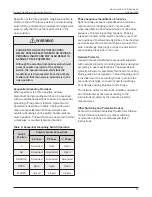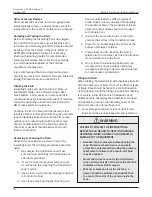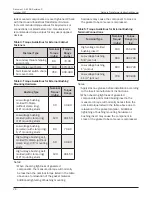
Document 2.4.128, Revision 3
October, 2017
21
Network Transformer Instruction Manual
WARNING
FAILURE TO FOLLOW THE INSTRUCTIONS
BELOW COULD RESULT IN DEATH OR
SERIOUS PERSONAL INJURY, AND
MAY ALSO RESULT IN DAMAGE TO THE
EQUIPMENT.
The transformer must be de-energized
before performing any maintenance work.
Transformers should be inspected periodically
while in service, with the frequency of inspection
determined by service conditions. Transformers
operating in unusual service conditions should be
inspected more frequently. Refer to IEEE Standard
C57.12.00 for a discussion of usual and unusual
service conditions.
Accessories such as PRVs, PRDs, temperature
gauges, fluid level gauges and drain valves typically
require no maintenance, except replacement in
the event of damage. Gauges should be checked
periodically to make sure they are operating properly.
When performing periodic maintenance, the checks
described below should be made at a minimum.
Periodic Inspection
All exterior surfaces of the transformer and the
transformer’s surroundings should be inspected.
Inspection frequency should be governed by
operating conditions at the installation site.
More severe conditions indicate the need for more
frequent inspection.
Inspection and Maintenance Checklist
While observing safe working practices, perform the
following checks.
1. Inspect for dents or other damage to metal
surfaces and make the necessary repairs
2. Inspect the paint finish for damage, corrosion
or weathering that exposes the primer coat or
bare metal. Repair any paint damage that might
be found. Refer to
“Exterior Paint Finish”
for
instructions.
3. Inspect thoroughly for evidence of fluid leaks,
including main tank, switch chamber, terminal
chamber, radiators, bushings, gauges, switches,
valves and all other accessories. Check fluid
level gauges or sight glasses to determine
fluid levels in all compartments. If a leak is
suspected, perform a pressure test according to
the instructions in “
Pre-energization Inspection
and Tests
.” Add fluid as necessary to ensure
that the proper fluid level is maintained. Repair
as necessary. Fluid leaks must be repaired
immediately to prevent serious damage to the
transformer and danger to personnel. Refer to
“
Fluid Leaks
” for instructions.
4. Visually check all gaskets for cracking or other
signs of deterioration. Replace as necessary.
When replacing a gasket carefully clean mating
surfaces to remove any rust, dirt, transformer
fluid, old gasket material, or other contamination
that might prevent a good seal. Use appropriate
gasket cement when installing new gaskets. Do
not reuse old gaskets. Six months after replacing
a gasket, check and re-tighten if necessary, being
careful not to overtighten.
5. Maintain a clean and unobstructed area around
the transformer, including sufficient clearance
around radiators to ensure adequate cooling of
the transformer.
6. Inspect the base of the transformer main tank
and make sure that there is no accumulated dirt
or other debris that might promote corrosion.
7. Check bushings, gauges, valves, switches and
all other accessories for proper operation, and
repair or replace any defective devices.
SECTION 7: MAINTENANCE








































